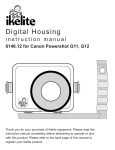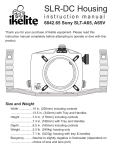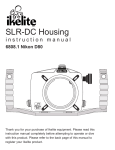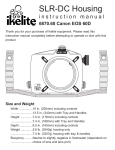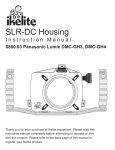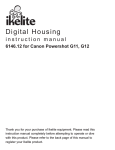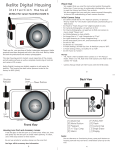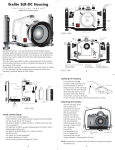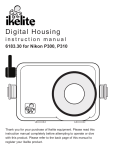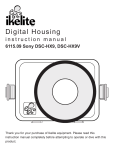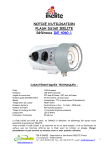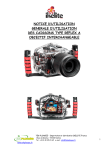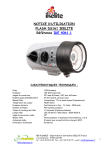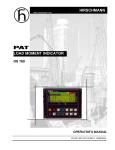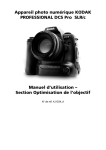Download Ikelite Product Instruction Manual
Transcript
D igital Hous i n g Instruction Manual 6970.01 Canon EOS 100D Rebel SL1 6970.02 Canon EOS 100D Rebel SL1 DSLR Waterproof TTL Housing, Camera, and Lens Kit Thank you for your purchase of Ikelite equipment. Please read this instruction manual completely before attempting to operate or dive with this product. Please refer to the back page of this manual to register your Ikelite product. Table of Contents Preparation ..................................................................P. 3 Specifications ..............................................................P. 4 What’s in the Box ........................................................P. 4 Parts of the Housing - Front View ..................................P. 5 Parts of the Housing - Back View ..................................P. 6 Housing and Camera Setup ........................................P. 7 STEP 1 - Attach Tray and Handle to the Housing ..........P. 8 STEP 2 - Initial Camera Settings ....................................P. 8 STEP 3 - Opening the Housing ......................................P. 9 STEP 4 - Installing Camera in the Housing ....................P. 9, 10 STEP 5 - Attach the Hotshoe ..........................................P. 11 STEP 6 - Closing the Housing ........................................P. 11 STEP 7 - Final Check......................................................P. 12 Usage ............................................................................P. 12 Turn Camera On..............................................................P. 12 Removing the Camera from the Housing........................P. 13 Strobe Use and Compatibility ....................................P. 14 Strobe Compatibility ........................................................P. 14 Ikelite Housing Conversion Circuitry ..............................P. 14 Attaching a Sync Cord to the Housing ............................P. 14, 15 Housing Lens/Port Options ............................................P. 16 Removing the Port ..........................................................P. 17 Installing the Port ............................................................P. 18, 19 Attaching an Ikelite Strobe Arm to the Housing Handle..P. 20 2 Table of Contents - continued Entering the Water ..........................................................P. 21 Spare Parts ..................................................................P. 21 Recommended Accessories ......................................P. 21 Maintenance ................................................................P. 22-25 Photo Tips ..................................................................P. 26 Troubleshooting ........................................................P. 27-29 Customer Support ......................................................P. 30 Limited Warranty ........................................................P. 30 Returning Products for Service ................................P. 31 Product Registration ..................................................Back Page Preparation This product has been water pressure tested at the factory and is depth rated to 200ft (60m). Thoroughly inspect and immerse the empty housing completely in water before installing a camera. If any fogging occurs or droplets of water enter the housing, do not install a camera. Clean the main housing o-ring and retest to make sure that it is watertight. Refer to the Troubleshooting section, page 27. Please read your camera manual thoroughly to have a full understanding of each camera function. If you are new to underwater photography, be sure to read the Photo Tips section, page 26. 3 Specifications (no camera installed) Controls ................................All important camera functions accessed Buoyancy ..............................Nearly neutral in saltwater Depth Rating..........................200 ft (60 m) Strobe Connection ................Ikelite Digital TTL ICS-5 5-pin Electrical ................................................Bulkhead plus TTL circuitry compatible with ................................................current model Ikelite DS strobes Use Built-in Flash..................No Tray and Handle Weight ......11.5 oz (327 g) Main O-Ring ..........................0110 Housing Dimensions ............6.4 x 7.5 x 5.9 in (164 x 189 x 150 mm) Housing Weight ....................3 lb 3 oz (1.4 kg) Housing Material ..................Polycarbonate front, acrylic back Dome Port Dimensions ........5 x 5.9 x 3.3 in (127 x 151 x 85 mm) Dome Port Weight ................13 oz (376 g) Dome Port Material ..............Optical grade acrylic - - 4 What’s in the Box Housing Tray with Quick Release Handle Dome Port with Zoom Sleeve and Neoprene Cover Waterproof Bulkhead Cap Spare Port O-Ring Spare Port Securing Thumbscrews for Dome Port Silicone 1cc Lubricant Tube 1 Year Manufacturer Warranty 6970.02 includes the Canon EOS Rebel SL1 18-55mm IS STM Lens Kit. Canon products are not produced, guaranteed or warrantied by Ikelite. Camera specifications have not been confirmed by Ikelite and are subject to change without notice. Parts of the Housing - Front View Housing controls are provided for all camera functions except the flash pop-up button, dioptric adjustment knob and depth-of-field preview button. Shutter Button Main Dial ISO Speed External Strobe Connector & Cap Zoom Control Lens Port Lid Snap External Tray Mounts Lens Release Button 5 Parts of the Housing - Back View Power/Movie Switch 4 INFO MENU 3 1 2 Av 7 5 6 8 9 10 11 12 13 14 1. MENU 2. INFO 3. 8. Live View/Movie Button 4. Mode Dial 5. 6. 7. Av 6 AF Point/Magnify Button AE/FE Lock Button 9. UP Cross Key LEFT Cross Key 10. SET Quick Control Button 11. RIGHT Cross Key 13. Playback Button 12. Aperture/Exp. Comp. Button 14. DOWN Cross Key Erase Button Housing and Camera Setup STEP 1 - Attach Tray and Handle to the Housing Using a 9/16” open/box end or socket Wrench (not supplied), firmly tighten the External Tray to the Housing Base using the two 3/8-16 Nuts supplied in the accessory package. Note: Tray and Handle may be attached before or after the camera is secured in the Housing. We recommend attaching it immediately to avoid scratching table tops with the Tray Mounting Bolts. External Tray & Handle Tray Mounting Bolt 3/8-16 Nut Wrench - not supplied 7 STEP 2 - Initial Camera Settings Setup your camera for underwater use and then adjust your settings once underwater. - - - * * * 8 REMOVE eyecup from camera’s optical viewfinder. Insert a fully charged camera battery. Set Mode Dial to “Av” Aperture Priority. If faster shutter speeds are desired, set Mode Dial to “M” Manual Mode; shutter speed to 1/125th second; aperture to F8, or F22 for macro photography (close-ups). Set ISO to “200.” IN MENU: Set Image Quality to “L” 18M and Image Review to “8 sec.” Set Red-eye Reduction to “Disable.” In Flash Control set Flash Firing to “Enable.” Set Auto Lighting Optimizer to “OFF.” Set White Balance to “AWB.” For best results, use manual Custom White Balance and reset for each working depth. Set AF Operation to “ONE SHOT AF.” Set Metering Mode to “ Center-weighted average .” Set Live View Shoot. to “Enable.” TIP: Turning off Live View Shooting will decrease shutter lag time. Set AF Method to “Quick Mode” and Aspect Ratio to “4:3.” Set Metering Timer to “4 sec.” IN MENU: Insert and format a high capacity SD card. Set Auto Power Off to “4 min” and LCD Auto Off to “Disable.” Set Touch Control to “Disable.” All other camera functions not mentioned should be set to the user preference. Many camera functions can be quickly set with the “Q-SET” button. Flash can be set through the camera menu. STEP 3 - Opening the Housing Lid Snaps have a Lock. 1. Push Lid Snap Locks forward and lift as shown. Open opposing Lid Snaps simultaneously. Keep pressure on the Lid Snaps so they do not fly open quickly. Some Lid Snaps have a lot of spring tension once they go over center, so keep a firm grip on each Lid Snap. Lid Snaps may also be opened one at a time. 2. Remove the Housing Back. Push Forward Lid Snap Lock Lift STEP 4 - Installing Camera in the Housing 1. Pull out on each housing control until it stops. This will get the controls out of the way for installation of the camera. 2. Remove camera lanyard from camera if attached. 3. The Mounting Plate is secured to the inside bottom of the housing. The camera Mounting Tray slides into the Mounting Plate. Use the index and middle fingers of each hand to pull the Tab section of the Mounting Tray away from the Mounting Plate, Diagram A. Use your thumbs to apply opposite pressure against the bottom of the housing to assist in removal. Diagram A Pull to Remove Mounting Tray Mounting Plate 9 STEP 4 - Installing Camera in the Housing - continued 5. Using a coin or flathead screwdriver (preferred), secure the camera Mounting Tray to the camera tripod mount, Diagram B. The Mounting Tray only attaches one way with the Tab to the back of the camera. An additional Tray hole allows attachment to a land tripod stand. Diagram B Tab Mounting Tray 6. Gently slide the camera with Mounting Tray back into the Mounting Plate, Diagram C. Using your thumbs, push against the Mounting Tray Tab until the Tray stops sliding forward into the Mounting Plate. Give the Tray an extra push to make sure it is properly seated all the way forward in the Mounting Plate, Diagram D. Diagram C Tab Mounting Tray Diagram D 10 Push Camera and Mounting Tray all the way forward into the Mounting Plate Mounting Plate STEP 5 - Attach the Hotshoe Slide Hotshoe into the top camera mount until it stops. Hotshoe must be all the way forward in the camera mount to assure a good electrical connection with a strobe. Make sure hotshoe cord does not interfere with the back when closing housing. Hotshoe STEP 6 - Closing the Housing 1. Place housing face down in your Lid Hook lap or on a flat surface. Check to Housing Back see that there is an o-ring on the housing back, and that it is clean and in its proper location. 2. Guide the back onto the housing Even gap on front. Make sure the hotshoe wire all four sides is out of the way. Once the back O-ring Lid is properly installed, the o-ring Snap should touch the housing all the way around. There should be an even gap on each side of the housing between the housing and the back. 3. Lift the lid snaps so they are extended and place each lid snap into the corresponding hook on the housing back. 4. To close the housing, push down on the opposing lid snaps simultaneously until they snap into place. Be sure they are down far enough to engage the lock - Page 9. The o-ring seal should now appear as a solid black line from the back of the housing. 11 STEP 7 - Final Check The clear housing permits instant visual inspection of the camera and sealing surfaces as well as complete monitoring of controls and camera LCD screens. This housing has been factory water pressure tested to 200 ft (60 m). Once the housing is closed, recheck the o-ring seal. Double check the gap between the housing back and the housing. It should be even all the way around the housing. Look through the clear plastic back at the o-ring. You should see a darkened area or solid black line where the o-ring is compressed against the housing back. If you do not see an even black compression seal all the way around the back, open the lid snaps, reseat the housing back and close the lid snaps. Visually check the seal again. The Housing Dome Port is attached from the factory and does not need to be removed unless you are installing optional 9304.43 Flat Port for the Canon EF-S 60mm Macro lens. The Dome Port Shade Extensions should be at the 6 and 12 o’clock position. If they are not, gently rotate the port on its base to align properly. Check the Port Thumb Screws for tightness using your thumb and index finger. The Thumb Screws should be hand-tightened only. If a Thumb Screw becomes missing or lost, there are spares included with the Housing. Usage Turn the camera on and operate each of the housing controls to get a feel for using the camera in the housing. Take a few test shots on land. 12 This housing is designed to be used specifically with available light or connected to an external strobe through the housing bulkhead ONLY. There is no room for the pop-up flash to operate, therefore, fiber optic cords cannot be used. If you are using an external strobe, see Page 14. Removing the Camera from the Housing 1. 2. 3. 4. Thoroughly dry Housing. Remove the Housing Back, Step 3, Page 9. Gently remove the Hotshoe from the Camera Mount. Place your index fingers over the top of the camera on opposite sides of the flash, Diagram E. Pull the camera backward and remove from the housing. If you are finished using the housing, remove the Mounting Tray from the camera bottom and slide it back into the Housing Mounting Plate, before replacing the Housing Back. Note: The Mounting Tray does NOT need to be removed when changing a camera battery or memory card. Diagram E 13 Strobe Use and Compatibility - Strobe Compatibility AF35 ........................no DS50........................yes, above serial number 70,000 DS51........................yes DS125......................yes, above serial number 5000 DS160, DS161 ........yes DS200......................yes Manta ......................no, except as secondary strobe triggered off primary Non-Ikelite ..............yes, manual flash exposure only Ikelite Housing Conversion Circuitry This small compact digital SLR housing has Ikelite designed and patented Conversion Circuitry built right in. The Conversion Circuitry provides real Canon eTTL flash exposure when used with Ikelite DS series strobes. Once a DS series strobe is attached to the camera housing, the conversion circuitry is automatically powered after the strobe is turned on. Once attached, turn the strobe on first before turning on the camera. The circuitry cannot be powered up or used by non-Ikelite strobes. If Manual flash is desired, press the button twice within 2 seconds and then use manual power settings on the strobe. To go back to TTL, turn the strobe off and back on; return strobe power switch to TTL. Attaching a Sync Cord to the Housing - Diagram F, Page 15 The Housing Bulkhead is designed to accept sync cords with Ikelite ICS-5 connector fittings. 1. Lightly lubricate the Sync Cord O-ring. Use ONLY Ikelite lubricant (supplied with housing). 2. Remove Bulkhead Cap from Housing Bulkhead. 14 Attaching a Sync Cord to the Housing - continued 3. Line up the Sync Cord Pins with the corresponding Bulkhead Receptacles. Gently insert Sync Cord into Bulkhead. DO NOT force this installation. If the Sync Cord does not seat properly inside the Bulkhead, then the Pins and Receptacles are improperly aligned (repeat Step 3). 4. Tighten the Knurled Nut snugly using your Index finer and thumb. DO NOT use pliers or other tools to tighten the Knurled Nut. - Always remove the Sync Cord from your Housing when not in use and replace the Bulkhead Cap. Diagram F Ikelite TTL Sync Cord Knurled Nut Sync Cord O-ring Bulkhead Cap Sync Cord Pin Housing Bulkhead 15 Housing Lens/Port Options 9304.52 Dome Port (included with housing) The housing comes standard with an optical grade acrylic dome port with zoom ring. This port provides sharp images and zoom capabilities with both the Canon EF-S 18-55mm STM kit lens, plus the popular Tokina 10-17mm lens. Minimal vignetting (dark shadows in the corners of the image) will be present in the 10-12mm range when used with the Tokina lens. A special zoom gear system allows the camera with lens attached, to be installed from the back of the housing without requiring removal of the dome port. No other lenses or ports are compatible with this compact housing with the exception of the 9304.53 optional Flat Port and Canon EF-S 60mm Macro lens. It is not necessary to remove the Dome Port unless you are installing the optional Flat Port or replacing the Dome Port. 9304.53 Flat Port (optional) The optional Flat Port allows use of the 60mm Macro lens in auto-focus mode and features 67mm front threads for the optional attachment of macro converter wet lenses. This housing is NOT compatible with Fixed Lens Ports or Modular Lens Ports from our standard DSLR Lens Port Systems. 16 Removing the Port The Dome Port never needs to be removed unless replacing the Gear Sleeve or installing the optional Flat Port. No tools are needed to remove the Dome Port and attach the optional Flat Port for the Canon EF-S 60mm Macro lens, Diagram G. 1. Three thumb screws secure the Port on the Base. Turn each thumb screw counterclockwise so at least 3 to 4 threads are showing. 2. Gently lift the Dome Port off the Port Base, Diagram H, Page 19. If the Port seems stuck, loosen the thumb screws another turn until the Port can be removed. Caution: DO NOT leave the Port off the Port Base for extended periods of time. This can result in debris being attracted to the port base o-ring resulting in a bad seal. Diagram G Approximately 3/32” gap will be present between the Housing Front and bottom of Port when the Dome or Flat Port is properly installed. Tighten Loosen 17 Installing the Port - Diagram H, Page 19 1. To reinstall, first check to see that there is a thin film of lubricant on the port base o-ring. The o-ring should appear slick. If necessary, relubricate with the supplied Ikelite lubricant. Do not use excessive lubricant which can attract hair or other debris. Use ONLY Ikelite lubricant. 2. Make sure the o-ring is free of hair or other debris. 3. The gear sleeve should be in its proper position inside the Port Base with the teeth facing up. REMOVE the gear sleeve when using the Flat Port. 4. Slide the Port over the Port Base until it STOPS. When properly installed, there should only be an approximate 3/32” gap between the bottom of the Port and the front of the housing, Diagram G, Page 17. 5. Rotate Port so the Shade Extensions are at the 12 and 6 o’clock position, and the Zoom Knob is opposite the Handle. 6. Snugly tighten the 3 thumb screws into the Port Base. DO NOT overtighten. No Thumb Screw threads will be visible once the Port is properly secured. 7. Check zoom function; Not applicable when using the Flat Port. * Use the same removal/installation procedure for optional 9304.53 Flat Port. The gear sleeve must be REMOVED before using the Flat Port. * We recommend placing the closed housing in a pool or bathtub to assure proper installation and watertightness before installing your camera. 18 Installing the Port - continued Diagram H Shade Extensions should be at the 12 and 6 o’clock positions. Zoom Knob Thumb Screw Gear Sleeve Port Base O-ring; should be lightly lubricated - use Ikelite lubricant only. 19 Attaching an Ikelite Strobe Arm to the Housing Handle To attach an Ikelite Arm to your Housing Handle, depress the spring-loaded Handle Push Button until it stops. Gently slide the pronged end of the Ikelite Arm into the hole in the top of the Handle as shown, Diagram H. When the Ikelite Arm is properly seated, the Handle Push Button will return to its starting position. Ikelite Arm Diagram H Housing Handle Handle Push Button 20 Entering the Water As soon as you enter the water, take a moment and check to see that the housing is properly sealed. We recommend you first water test the housing with no camera inside to assure a safe and watertight environment. Next, check to see if there are any bubbles on the face of the lens port. If there are, take your finger and remove them. If there are bubbles on the lens port they can produce soft focus spots in your photos or video. - Spare Parts (available through Ikelite or any Ikelite Dealer) 0110 Main o-ring 0587.31 Port securing screw 9104.5 Waterproof Bulkhead Cap 0184.2 Silicone Lubricant 2cc Reclosable Tube - 9569.01 Camera Mounting Tray 5509.19 Gear Sleeve 0132.36 Port Base O-ring 0200.1 Port cover Recommended Accessories Flat Port 9304.53 Designed specifically for the Canon EF-S 60mm Macro lens. Tray + Dual Handles 9523.62 Add stability and gripping point(s) for comfortable use of the housing. Add a second strobe to eliminate shadows and evenly light your subjects. External Strobes An external strobe restores the warmer colors filtered out by water and also illuminates the subject. The camera’s flash is not accessible through the housing, therefore, an external strobe is recommended. 21 Video Lighting External video lights add color when using the video/movie mode of your camera. Primary video lights are specially color balanced to provide natural tones. A full range of accessories are available to support your housing. Please visit www.ikelite.com to see the most current information about recommended accessories for your housing. Maintenance Lens Port Treat the acrylic in the lens port as a camera lens. After use, rinse and gently dry the outside lens port to avoid water spotting. To clean, use a mild soap solution or lens cleaner. It is NOT necessary to remove the Port for cleaning. Do not rinse the inside the Port. Do not use alcohol or window cleaner on the Lens Port. Lubricant 22 Ikelite provides silicone lubricant with the housing. We recommend you use only Ikelite lubricant on Ikelite products. Other brands may cause the main housing o-ring to swell and not seal properly. Use only enough lubricant to lightly cover the main housing o-ring or lubricate a sticky control. Wipe off any excess lubricant with a clean cloth. Lubricant is not a sealant; it is used to reduce friction. Excessive lubricant can collect sand and dirt which may interfere with proper sealing. CAUTION: Never use spray lubricants as the propellant ingredient can cause the plastic housing to crack or o-rings to swell. Housing Maintenance - - - - Your Ikelite Digital Housing should be given the same care and attention as your other photographic equipment. In addition to normal maintenance, we recommend that the housing be returned to Ikelite periodically to be checked and pressure tested. Do Not leave the camera and housing in direct sunlight for prolonged periods. Heat may damage the camera. Do Not ship the camera in the housing. Before using the housing, always check the tightness of the set screw in each control knob. Check each control gland penetrating the housing to make sure they are tight. There is a slight chance that either could vibrate loose during travel. Keep the main housing o-ring clean and lightly lubricated. To lubricate, remove the o-ring from the back. Put a small amount of lkelite lubricant on your fingers. Pull the o-ring through your fingers to apply a thin coating of lubricant. Only apply enough lubricant to make the o-ring feel slick. Do Not stretch the o-ring. This light coating of lubricant will help to keep the o-ring from drying out and will help to show a dark sealing line when the housing back is properly sealed. Keep the area where the o-ring fits and the sealing surface of the housing clean. Rinse the housing exterior thoroughly in freshwater after each saltwater use. Depress push buttons repeatedly in freshwater to eliminate trapped saltwater. Dry with a soft cloth. Dry lens port to eliminate water spotting. After several uses in saltwater, soak the housing exterior in a mild soap solution; rinse and dry before storing. When storing the housing, remove the back o-ring, lightly lubricate, and place in a plastic bag. Place the plastic bag with o-ring inside the housing for safe keeping. If removing a housing push button, Do Not re-use the E-clip. Contact Ikelite for replacement E-clips (part 0319.12). Leave lid snaps in the open position when not using the housing for extended periods. 23 Control Maintenance - Ikelite controls are designed to provide years of reliable service with minimal maintenance. Push button controls normally require no maintenance other than rinsing in freshwater after saltwater use. Depress each push button in freshwater several times to eliminate trapped saltwater. If a push button control becomes difficult to push or if it sticks when depressed, soak the housing in luke warm freshwater. After a few minutes, operate the push button. If this does not correct the problem, return the housing to Ikelite for maintenance. If you are on a trip and unable to return the housing immediately, a push button may be lubricated by pressing and holding the push button all the way in. Then, use your finger or other small non-metal object to place a small amount of lube at the base of the shaft inside the housing. Press and release the push button several times until the lube is worked up into the o-ring. After completing this procedure, close the housing and submerge it in water without the camera inside. Check the control for watertightness. Diagram I Apply Ikelite Lube here 24 Control Maintenance - continued In the unlikely event one of the larger gland style control shafts sticks or becomes difficult to operate, you can remove the control from the housing and lubricate it, or return the housing to Ikelite for maintenance. To remove the control, Diagram J, loosen the set screw in the knob (allen wrench required); remove the knob. If there is salt or dirt build-up on the exposed control shaft, clean the shaft. Open the housing and gently slide the control shaft out of the control gland. Clean and lightly lubricate the shaft, including the end of the shaft. Slide the shaft back into the control gland and gently slide it back and forth a few times without fully removing the shaft from the gland. Replace the knob, noting the flat area on the shaft. The set screw in the knob should tighten down against the flat area on the control so the knob does not turn on the shaft. After completing this procedure, close the housing and submerge it in water without the camera inside. Check the control for watertightness. Diagram J Housing Gland Control Shaft Tighten set screw down against this flat area when replacing the knob. Lubricate end of shaft before reinserting into gland Loosen set screw (allen wrench required) 25 - - - - - - 26 Photo Tips The number one rule in underwater photography is to eliminate as much water between the camera and subject as possible. Get as close as you can to the subject, then use the zoom. If you are using flash for still photos, subjects beyond 6 feet (1.8m) will not have much color regardless of strobe power. Photograph in clear water; do not stir up the sand or silty bottom. If backscatter becomes a problem in the environment you are photographing, an external flash will help eliminate much of the backscatter. Many digital cameras have a slight lag time between when you press the shutter release button and the camera actually takes the picture. Hold the housing steady a second or two after pressing the shutter release button. Do not shoot down on subjects as they will quite often blend into the background and be difficult to see in the photograph. Shoot subjects straight on or shoot up at a slight angle using the blue water as a contrasting background. When using daylight or flash, if your camera consistently over or underexposes the image, you may want to adjust your camera’s exposure compensation or flash exp. comp. settings. If you error in exposure, it is better to have the image slightly underexposed rather than overexposed. An overexposed image is missing color information which cannot be adjusted in a photo processing program. A slightly underexposed image has color information that can be adjusted. It is important to respect all living creatures underwater, including people, marine life, and coral. While we encourage people to get close to their subjects when taking a photograph, they should not touch, lie on, or in any way disturb the things they find underwater. Troubleshooting Problem Solution Image is over/underexposed, or a corner of the image is dark - Check that the strobe is firing when taking a picture. Camera flash should be forced “on.” - When using an external strobe, make sure it is turned on, set properly, and its battery is charged. - Check all corded connection points. - Change camera shutter speed or aperture. - Move closer to or further away from the subject. - Adjust Flash Exposure Compensation . Push buttons or - Remove the camera and rinse the closed housing controls are sticky or in freshwater. Vigorously press each push button hard to operate in and out several times to release any trapped saltwater or debris. - Press a sticky push button all the way in and place a small amount of lube on the small end of the push button shaft at it’s base. Release and operate the push button several times to distribute the lube, Diagram I, Page 24. - If a larger gland style control is sticky, grab the control knob, pull it out, and then push back in. If still sticky, see the Control Maintenance section, Diagram J, Page 25. - Camera eyecup must be removed. - Return housing to Ikelite for routine maintenance. 27 Problem Solution Camera does not take a picture - Install a fully charged battery. - There is not enough available light for the camera to properly focus. Add a focusing light or strobe with a built-in focusing or video light to your system. - Select a center focus point in your camera menu. Housing is hard to close - Make sure the camera is mounted properly in the housing and controls are out of the way. - Main housing o-ring is not seated properly. - Hotshoe cord is in the way. Fogging occurs on the Lens Port - Humid air is trapped inside the housing. The camera produces heat and may condense any trapped moisture forming fog on the lens port. Close the housing in an air-conditioned room or vehicle, or in front of an air-conditioner. - The housing should not be in direct sunlight for an extended period of time. - Purchase desiccant packs also known as moisture munchers from a local camera store. Place one or two new packs in your housing before each day of diving. - If moisture or water droplets are present around the controls or sealing areas, return the housing to Ikelite for evaluation. - Clean the main housing o-ring and sealing surface of the housing. 28 Problem Water enters the housing Solution - Remove, clean and properly lubricate the main o-ring. - Look for hair, dirt, or foreign debris crossing the o-ring seal. - Reassemble the housing without a camera installed and pressure test or take diving. - Return housing to Ikelite for evaluation. Pictures are too blue - Use custom (manual) white balance. or too green - Add an external strobe. - Move in closer to your subject when taking a picture. Reset for each working depth or when attaching a color correcting filter to the camera lens. - Add an optional color correcting filter to the camera lens. 29 Customer Support Please read the troubleshooting section of this instruction manual before contacting Ikelite Customer Support. Ikelite Underwater Systems Service Department 50 West 33rd St. Indianapolis, IN 46208 USA Email: [email protected] Phone: 317-923-4523 Limited Warranty This Ikelite product is warranted against any manufacturing defects for a period of one (1) year from the original date of purchase. Defective products should be returned to Ikelite postage paid. Ikelite will, at its sole discretion, repair or replace such products, and will return to customer postage paid. All other claims of any nature are not covered. Except as mentioned above, no other warranty expressed or implied applies to this Ikelite product. 30 Returning Products For Service Ikelite is most interested in performing any service to ensure that all products perform as intended. Evidence of purchase date must be provided to obtain warranty service. No prior authorization is required. You may return directly to us or through your dealer. Please include a brief description of the problem, any relevant email correspondence, and/or instructions on what you want us to do. Always include name, shipping address, email address, and phone number inside of the package. Send postage paid to: Ikelite Underwater Systems Attention: Service Department 50 West 33 Street Indianapolis, IN 46208 USA No reimbursements for postage paid will be issued. You may also want to insure the package. Returning Products for Service - outside the United States For the separate international customs documentation form that you complete to accompany the shipment, please state or designate that the enclosed products were originally manufactured in the USA and are being returned to the manufacturer for repair service. Value of the equipment listed for customs purposes should be zero. 31 Product Registration Please go to www.ikelite.com to register your Ikelite housing within 15 days of purchase. Ikelite Underwater Systems 50 West 33rd Street Indianapolis, IN 46208 USA www.ikelite.com © 2014 Ikelite Underwater Systems 6970.01_Canon_SL1_01-0314
































